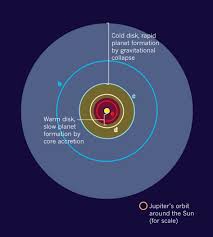Overview:
From the time that Galileo and other astronomers observed that some stars were double, scientists have been fascinated with the thought that stars other than the sun might have planets that orbit them. The most recent discoveries by the Hubble and the Kepler Space Telescopes suggest that planets may be more common in the universe than even science-fiction writers think.
How Planets Are Formed
Stellar systems are formed from clouds of interstellar gas and dust, held together by gravitational attraction. About the time the protostar gains enough mass and heat to start nuclear fusion and shine on its own, the remaining gas and dust flattens out into a disk that surrounds the young star. If dust and ice particles coalesce enough within the disk, their gravity attracts enough mass that they can eventually become planets with stable orbits around the star or stars in the center.
Discovery of Exoplanets
Exoplanets are planets that exist outside the solar system. Philosophers and scientists thought they might exist, and even thought that they might have discovered some in the 19th century. Telescopes were not powerful enough to see a body that didn’t shine on its own at a very far distance. Therefore, the earliest discoveries of planets outside the solar system were not until the 1990’s.
Star or Planet?
In order for a planet to be classified as a planet and not as a star, it must be no more than 13 to 25 times the mass of our planet Jupiter. That is because thermonuclear fusion is possible in a stellar object that large. If a larger body is detected it is usually classified as a brown dwarf in the beginnings of nuclear fusion. The core of a brown dwarf must generate enough pressure to facilitate hydrogen to fuse into helium.
Are Multiple Star Systems More Likely to Have Planets?
The process of stellar formation into systems with binary or multiple stars seems to increase the likelihood that planets will coalesce as part of the process. Many multiple star systems have oscillating or variable brightness. Sometimes this is caused by reactions within the star itself. Sometimes it is caused by one member of the system eclipsing another. By careful observation, astronomers have been able to discover more than 1800 star systems that have exoplanets. Some of these have been photographed by the Hubble space telescope, the NASA space telescope Kepler, and other space missions.
Interested in science tutoring services? Learn more about how we are assisting thousands of students each academic year.
SchoolTutoring Academy is the premier educational services company for K-12 and college students. We offer tutoring programs for students in K-12, AP classes, and college. To learn more about how we help parents and students in Lansing, MI: visit: Tutoring in Lansing, MI




